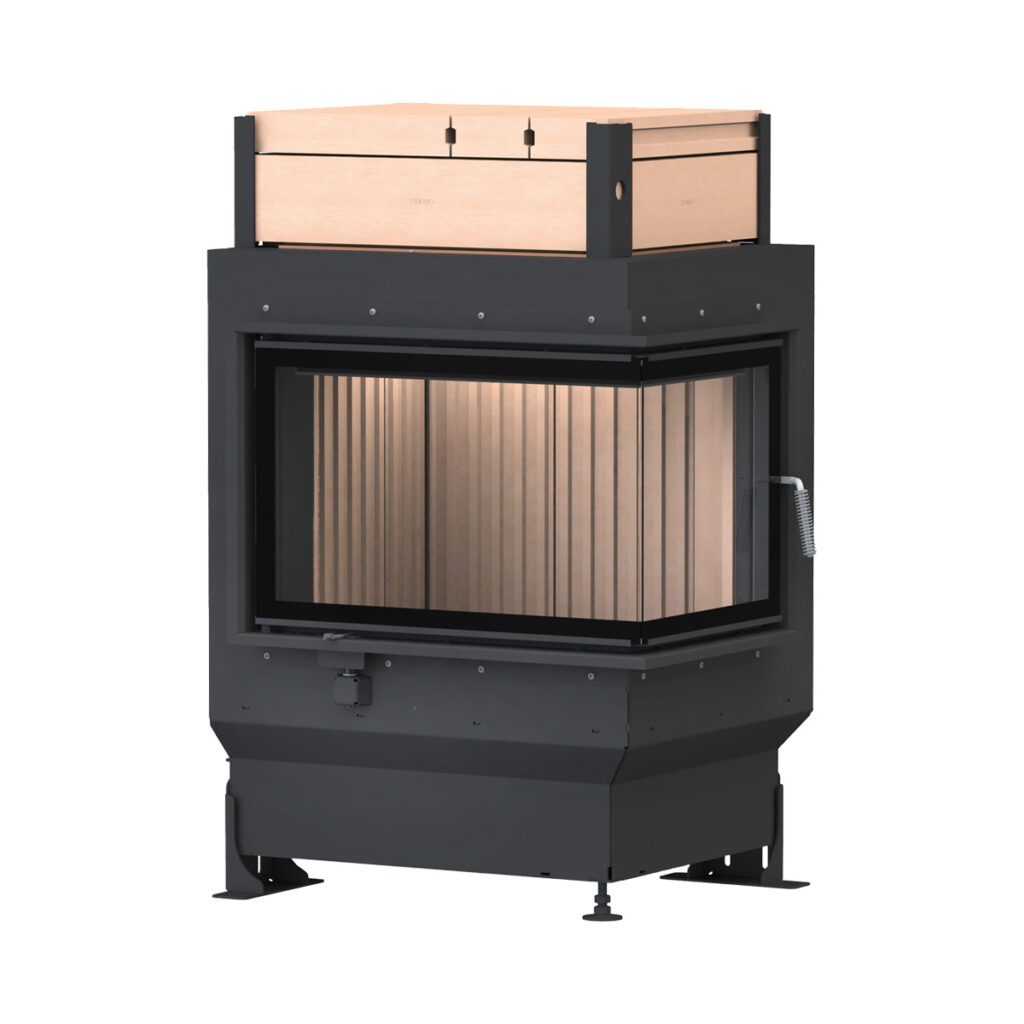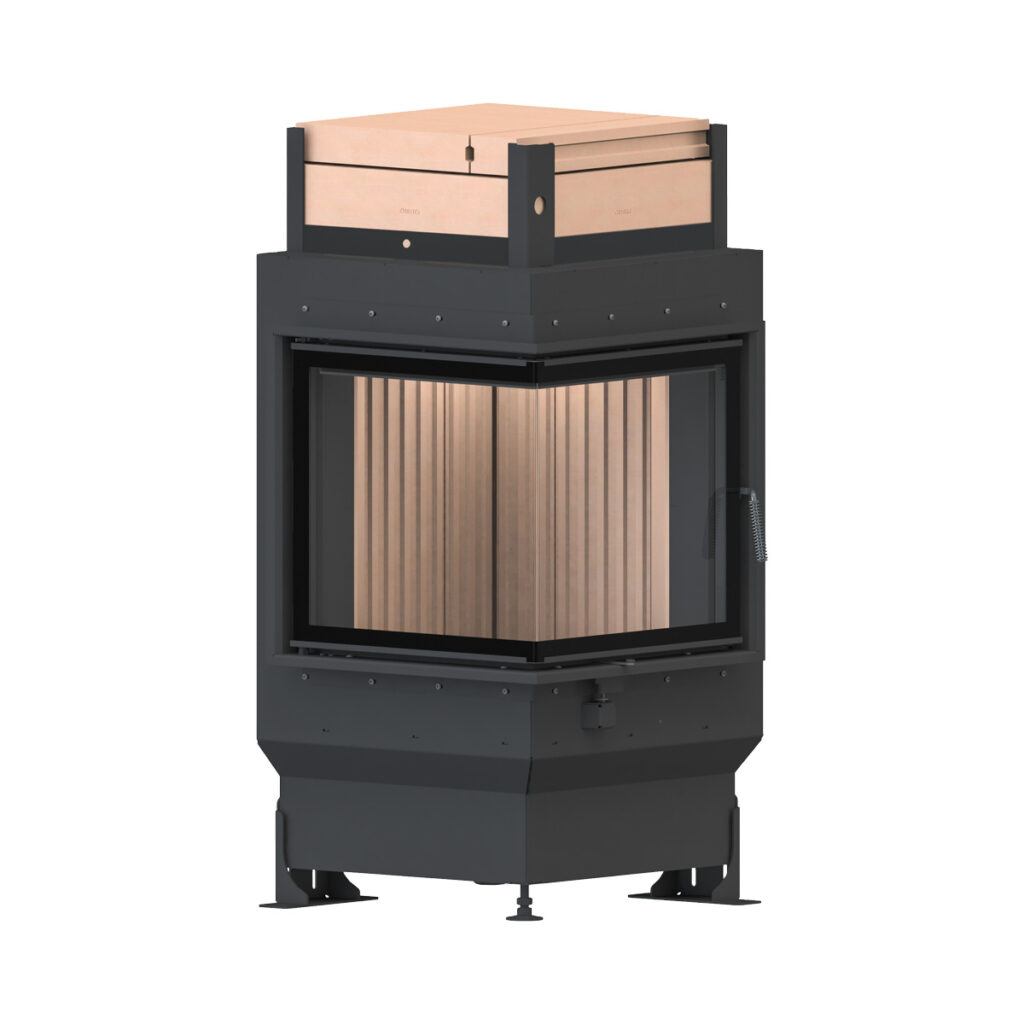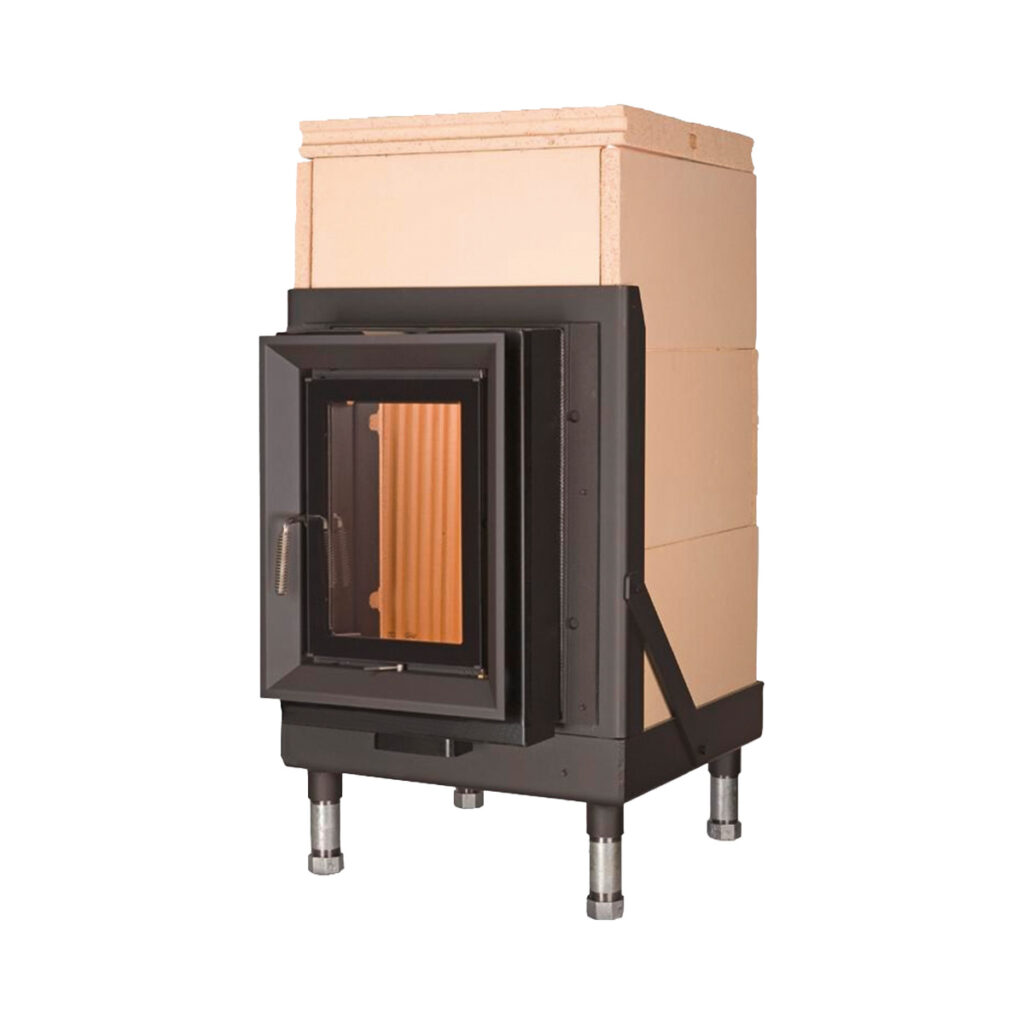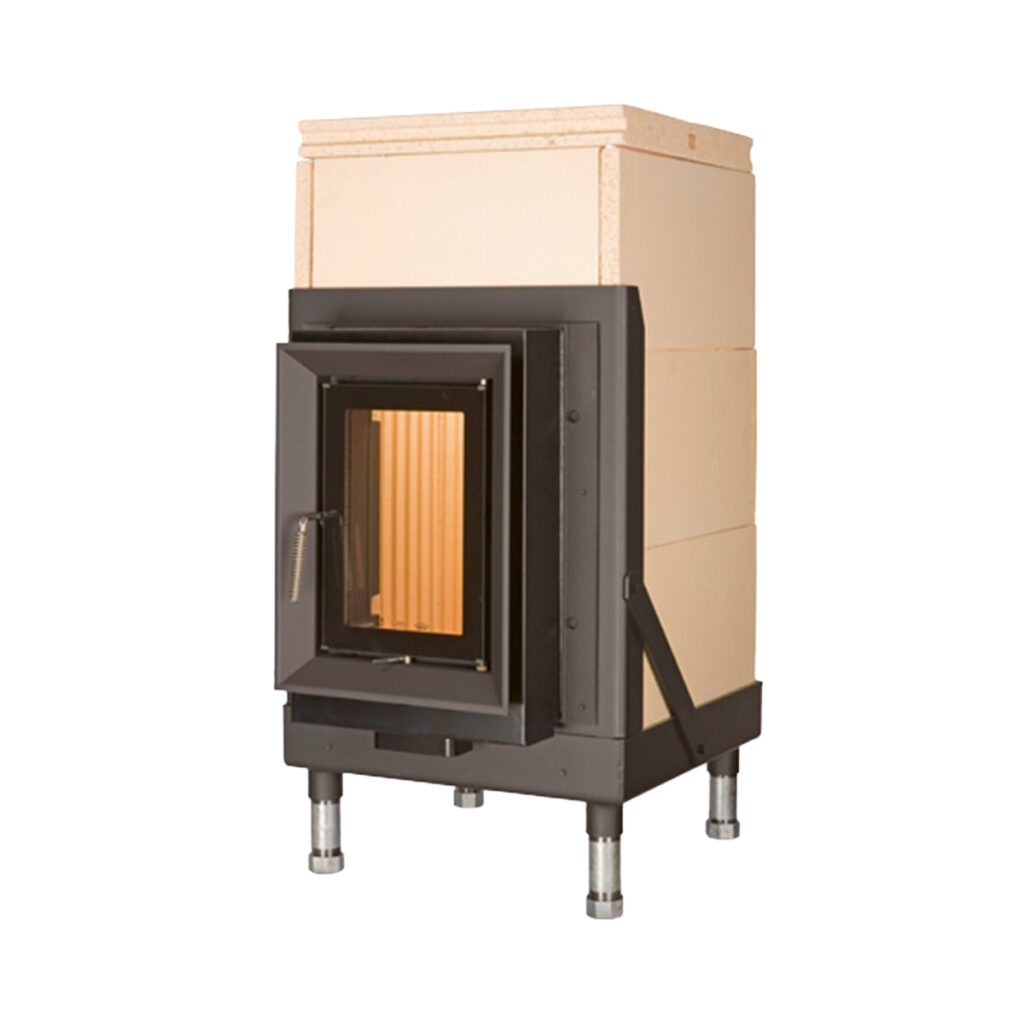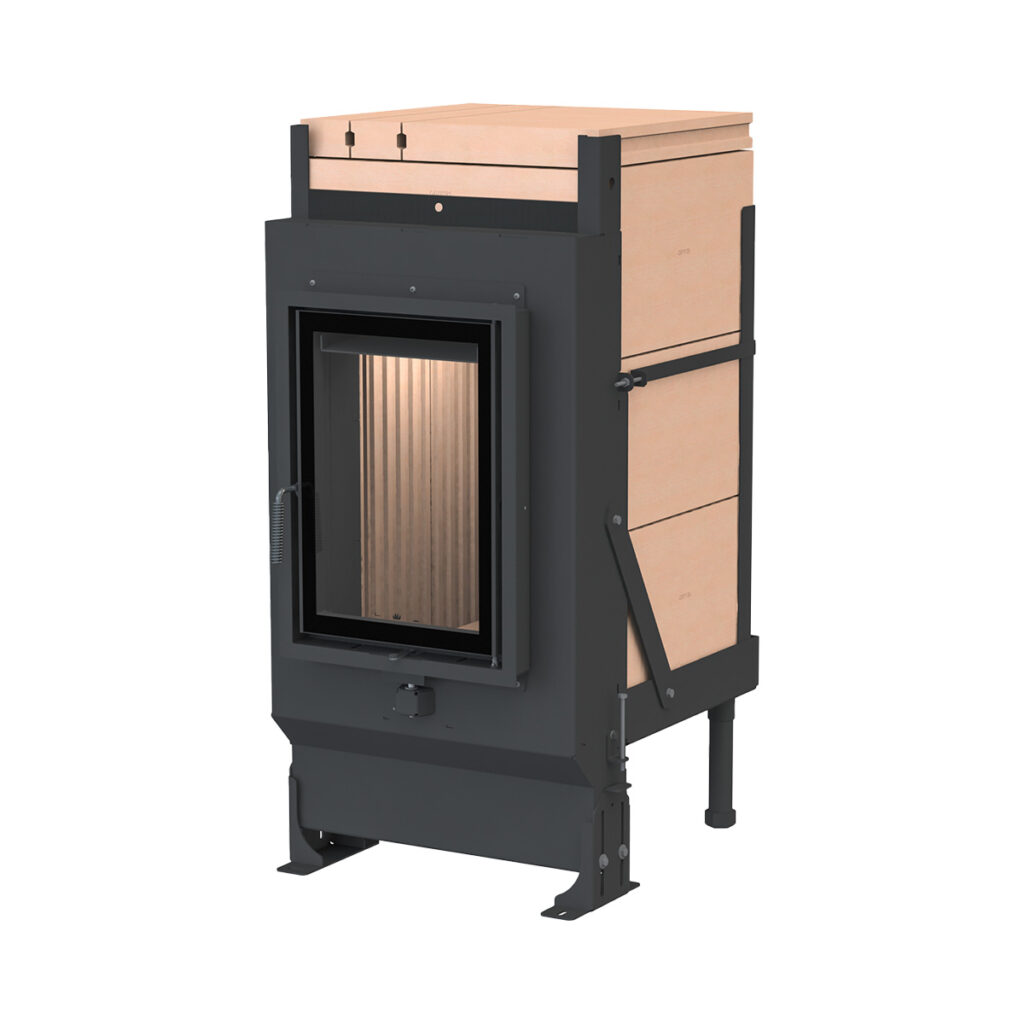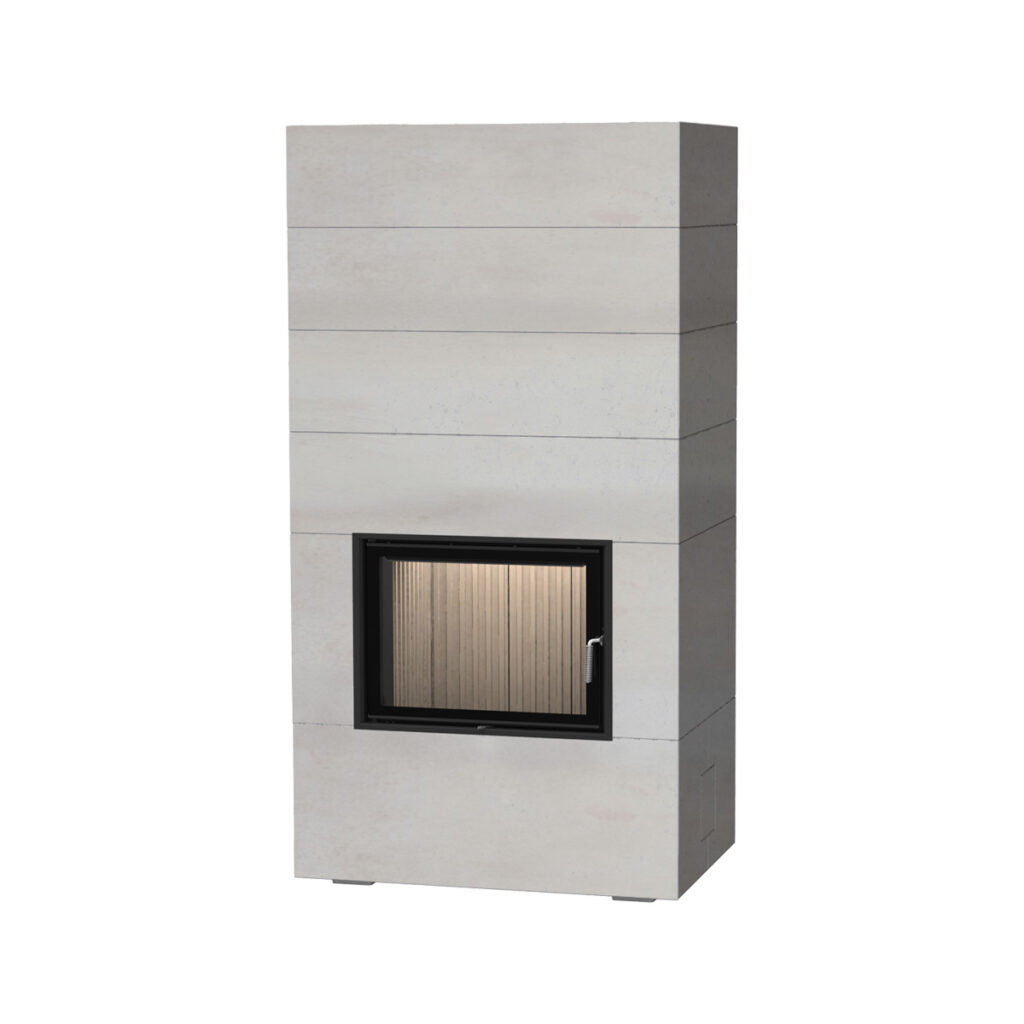More heating power is not possible: exceptionally long-lasting heat storage
A masonry heater, also known as a storage stove or radiant stove, heats the room with pleasant radiant warmth. It is considered the most traditional form of tiled stove and is usually handcrafted by a stove builder. However, BRUNNER also offers pre-fabricated components such as a firebox made of chamotte or additional storage mass placed on top or beside the unit.

The features
- 1. Cast iron masonry heater doors
With different door formats, radiant stoves can be built with various glass panel sizes to suit individual preferences. While the fire is still burning inside the stove, the radiant heat through the viewing window quickly warms the room. However, the size and geometry of the glass should always be selected according to the heat requirements of the installation space.
- 2. Door connection kit
A component attached to the firebox door of the masonry heater to regulate the air supply and ensure a secure connection to the heating system or to the outside air.
- 3. Masonry heater firebox made of chamotte
The tested fireboxes are available in various sizes and designs, with either a large or small viewing window. For smaller masonry heaters, the single-layer box firebox, or KFR for short, is used – featuring a compact design and a smaller viewing window.
Since large masonry heater fireboxes with bigger windows are exposed to greater thermal and mechanical stress, these stove bodies are always built with a double-layer structure. This means that the inner combustion chamber, which is directly exposed to the fire, can expand and move thermally while being securely held together by a second outer shell.
- 4. Operating convenience: manual or automated
The combustion air can be easily adjusted by hand using a single lever. Symbols on the glass provide helpful guidance for this.
Even greater convenience is achieved with an electronic combustion control system (EAS). With this, you only need to ignite and refuel the fire – everything else is handled automatically by the control unit. The result is optimal efficiency, as the EAS actuator never forgets to make fine adjustments and reliably stops the air supply once the burn cycle is complete. This is a major advantage, especially when you can’t tend to the stove after lighting it – for example, when you leave the house or go to bed.
The four glass pane options

Masonry heater with flat glass panel
This version offers a frontal view of the fire and, depending on the selected masonry heater door, more or less visibility of the flames.

Masonry heater with corner glass panel
The corner masonry heater combines the advantages of a tiled stove with those of a fireplace – cozy warmth and glass panels in a fireplace format. Visually, the corner masonry heater is indistinguishable from a modern corner fireplace. With components precisely matched for optimal heating performance and crafted by skilled professionals, these storage heaters offer an enjoyable and efficient wood-burning experience.

Masonry heater in tunnel version
The tunnel version, with two viewing panels, offers a view of the flames from both sides of the room. This makes the tunnel masonry heater an excellent choice when it is intended to serve as a room divider.

System masonry heaters
BRUNNER system masonry heaters are somewhat like a masonry heater kit that is assembled by a professional stove builder. They are an excellent choice when no custom shapes or layouts are required. The selected masonry heater firebox is combined by the installer with the corresponding modular storage and cladding kit. The surface, finished in a concrete look, can then be painted or plastered. A solid storage heater cannot be built faster or more cost-effectively.
The masonry heater for primarily radiant heat
BRUNNER system masonry heaters are somewhat like a masonry heater kit that is assembled by a professional stove builder. They are an excellent choice when no custom shapes or layouts are required. The selected masonry heater firebox is combined by the installer with the corresponding modular storage and cladding kit. The surface, finished in a concrete look, can then be painted or plastered. A solid storage heater cannot be built faster or more cost-effectively.

Radiant heat
It works on a principle similar to that of solar heat: rays move through the room and hit solid or liquid surfaces, which absorb the radiation and warm up from within. For people, radiant heat quite literally gets under the skin. Because the warmth is transferred directly to the body, it feels more intense. As a result, the room temperature can be set lower, which in turn saves heating costs.

Convection heat
In contrast, convection heat transfers warmth through the air from one place to another. The principle of convection heating is simple: air heats air.
A traditional masonry heater naturally provides a high proportion of pleasant radiant heat in the form of long-wave infrared radiation, which warms the room evenly. This prevents cold zones from forming near the floor. The height and duration of the heating output depend on the amount of storage mass. The rule is: the more storage mass built into the stove, the gentler its surface temperatures – making it difficult to overheat a room. This property is especially desirable in low-energy homes.
The masonry heater as
slow-response stove
Modular storage stones as shaped components for heat storage systems
Because the heat energy from a masonry heater insert must first pass through the storage materials, it takes significantly longer to heat up than a warm-air stove. This means that while a masonry heater continues to provide warmth for many hours after the fire has burned down, it also requires a longer heating-up period.
The connection of storage modules in BRUNNER masonry heater fireboxes is made using flue connection stones. The material is designed to withstand high thermal stress. Ceramic modular storage stones can be used for masonry heaters, tiled stoves, or fireplaces – essentially anywhere that heat storage is desired.
The advantages of these pre-fabricated storage elements are clear: precisely fitting components allow for fast construction, their smooth surfaces and consistently round cross-sections ensure minimal flow resistance, and their significantly higher raw density compared to conventional chamotte flues combines exceptional heat absorption and conductivity in a compact footprint.

Our Masonry heaters
Glass pane format
FAQ masonry heaters
- Can a masonry heater also be built as a water-bearing stove?
Yes, as a water-bearing heating stove, the masonry heater supports the home’s central heating system and thus helps save money.
- How often should a masonry heater be fired?
Ideally, at least once a day throughout the entire heating season. The exact design of a masonry heater and the desired level of heat output are usually determined by the customer and the size of the installation room.
- Is heating with a masonry heater environmentally friendly?
A masonry heater whose combustion chamber is built by hand can only be as environmentally friendly as its user is skilled. That’s why BRUNNER offers type-tested, prefabricated masonry heater combustion chambers and doors. This ensures a clean solution in terms of emissions and efficiency—without sacrificing the authentic masonry heater experience. Thanks to the maximum energy yield achieved through the mineral combustion chamber and the massive heat storage surface, the masonry heater is arguably the most efficient way to heat with wood.
And for many of our customers, it’s also the most beautiful one. - What does a masonry heater cost?
A modern masonry heater is much more than just an evolution of Grandma’s tiled stove. Then as now, the stove forms the heart of any home – because warmth is a basic human need. Investing in a masonry heater is therefore always worthwhile, as the focus here is not just on the fire, but on the heating performance it provides.
Prices for masonry heaters start at around €5,000, depending on the model – this does not include the stove builder’s labor. The more exclusive the design or materials, the higher the cost of the fireplace. It’s also important to clarify in advance whether the existing chimney is suitable for operating a masonry heater. If not, modifications will be required, which will further increase the overall cost.
- What is the difference between a tiled stove and a masonry heater?
A tiled stove, consisting of a cast iron heating insert with a metallic or ceramic heat storage surface and an additional storage mass, heats up comparatively quickly and provides long-lasting warmth. It emits heat both through radiation and via warmed air. It can be fired up at any time, and wood can be added for even longer-lasting comfort. Once cooled, a tiled stove also reheats significantly faster than a masonry heater.
A masonry heater, on the other hand, operates more slowly. Built primarily from heat-retaining materials, it warms up gradually but stores heat for a very long time, releasing it almost exclusively as pleasant radiant heat. Because of its long heating time, a masonry heater should never be allowed to cool down completely during the heating season – adding wood at least once a day is necessary to maintain warmth.
- What is a masonry heater?
Similar to a tiled stove, a masonry heater is also a so-called storage stove. It stores thermal energy in a subsequent mass and releases it gradually into the living space over an extended period of time. The difference compared to a tiled stove is that a masonry heater is built from mineral storage materials (e.g. fireclay bricks). This makes masonry heaters even better suited for long-lasting heat transfer than tiled stoves. Especially in alpine regions, there is a long tradition of this very original form of wood heating. Masonry heaters are often still built entirely by hand.
BRUNNER craftsmen search
If you are interested in a BRUNNER stove or heating system, please contact one of our craftsmen.

